f61e4991eb39b3717770069c4597cee0.ppt
- Количество слайдов: 180

Security Courtesy of Alvert Levi with Sabanci Univ.

Terminology • Computer Security – automated tools and mechanisms to protect data in a computer, even if the computers are connected to a network • against hackers (intrusion) • against viruses • against Denial of Service attacks • Internet (network) Security – measures to prevent, detect, and correct security violations that involve the transmission of information in a network or interconnected network

Attacks • Passive attacks – interception of the messages • Eavesdropping – What can the attacker do? • use information internally • release the content • traffic analysis – Hard to detect, try to prevent

Attacks • Active attacks – Involves interruption, modification and fabrication, etc. – Masquerade, impersonating • pretend as someone else • possible to get more privileges – fabrication • create a bogus message – Replay • passively capture data and send later – Denial-of-service • prevention the normal use of servers, end users, or network itself

Masquerade Replay

Attacks • Active attacks (cont’d) – deny • repudiate sending/receiving a message later – Modification (tampering) <-> intact • change the content of a message

Basic Security Services • Authentication <-> impersonation – assurance that the communicating entity is the one it claims to be – peer entity authentication • mutual confidence in the identities of the parties involved in a connection – Data-origin authentication • assurance about the source of the received data • Access Control – prevention of the unauthorized use of a resource • Data Confidentiality – protection of data from unauthorized disclosure – traffic flow confidentiality is one step ahead

Basic Security Services • Data Integrity <-> tampering – assurance that data received are exactly as sent by an authorized sender – I. e. no modification, insertion, deletion, or replay • Non-Repudiation – protection against denial by one of the parties in a communication – Origin non-repudiation • proof that the message was sent by the specified party – Destination non-repudiation • proof that the message was received by the specified party

Security Mechanisms • Basically cryptographic techniques/technologies – that serve to security services – to prevent/detect/recover attacks • Encipherment – use of mathematical algorithms to transform data into a form that is not readily intelligible • keys are involved

Security Mechanisms • Message Digest – similar to encipherment, but one-way (recovery not possible) – generally no keys are used • Digital Signatures and Message Authentication Codes – Data appended to, or a cryptographic transformation of, a data unit to prove the source and the integrity of the data • Authentication Exchange – ensure the identity of an entity by exchanging some information

Security Mechanisms • Notarization – use of a trusted third party to assure certain properties of a data exchange • Timestamping – inclusion of correct date and time within messages • Non-cryptographic mechanisms – traffic padding (for traffic analysis) – intrusion detection • monitor, detect, and respond – firewalls

And the Oscar goes to … • On top of everything, the most fundamental problem in security is – SECURE KEY EXCHANGE • mostly over an insecure channel – Let’s brainstorm on this issue!

Model for Network Security

Model for Network Access Security

Aspects of Computer Security • Mostly related to Operating Systems • Similar to those discussed for Network Security – – – Confidentiality Integrity Availability Authenticity Accountability Dependability

Meaning of Cryptography • from Greek – Cryptos: secret, hidden – graphos: writing – cryptography: study of secret writing

Basics Encryption key Decryption key Message Ciphertext Encryption Decryption (plaintext cleartext) (Encipherment) (cryptogram) (Decipherment) plaintext

Basic Terminology • plaintext - the original message • ciphertext - the coded message • cipher - algorithm for transforming plaintext to ciphertext • key - info used in cipher known only to sender/receiver • encipher (encrypt) - converting plaintext to ciphertext • decipher (decrypt) - recovering ciphertext from plaintext • cryptography - study of encryption principles/methods • cryptanalysis (codebreaking) - the study of principles/ methods of deciphering ciphertext without knowing key • cryptology - the field of both cryptography and cryptanalysis

Kerckhoff’s principles “The opponent is not to be underestimated. In particular, the opponent knows the encryption and decryption algorithms. So the strength of a cipher system depends on keeping the key information secret, not the algorithm” A. Kerckhoff, 1883

Characteristics of Cryptosystems • types of operations for transformation into ciphertext – substitution – Transposition/permutation – product • multiple stages of substitutions and transpositions • number of keys used – single-key or private or secret (symmetric) – two-key or public or (asymmetric) • the way in which plaintext is processed – Block cipher – Stream cipher

Symmetric cryptography

Symmetric Encryption • also known as – – Classical, conventional private-key single-key Secret key • sender and recipient share a common key • was only type prior to invention of publickey cryptography – until second half of 1970’s

Symmetric Cipher Model there must be a secure mechanism for the distribution of this key a priori

Requirements • two requirements for secure use of symmetric encryption: – a strong encryption algorithm – a secret key known only to sender / receiver Y = EK(X) X = DK(Y) • assume encryption algorithm is known • implies a secure channel to distribute key

Towards modern cryptography • Product ciphers – general name for having multiple stages of substitutions, permutations or both – aim: to make cryptanalysis difficult by having irregularities in the cipher – this idea led to Fiestel cipher and DES (Data Encryption Standard) • bridge between classical and modern ciphers

Modern Ciphers • Block ciphers vs. Stream Ciphers • Block ciphers operate on a block of data – entire block must be available before processing • Stream ciphers process messages a bit or byte at a time when en/decrypting – need not wait the entire block • Most ciphers are block ciphers – but it is possible to use a block cipher as a stream cipher (modes of operations)

DES (Data Encryption Standard) • most widely used block cipher in world – several rounds of substitutions and permutations • Black box view

DES Characteristics • DES shows strong avalanche effect – one bit change input affects on average half of the output bits • cf. diffusion – to make attacks based on guessing difficult • S-boxes are non-linear – provides confusion • i. e. makes relationship between ciphertext and key as complex as possible

Substitution-Permutation Ciphers • in 1949 Claude Shannon introduced idea of substitution-permutation (S-P) networks – modern substitution-transposition product cipher • these form the basis of modern block ciphers • S-P networks are based on the two primitive cryptographic operations we have seen before: – substitution (S-box) – permutation (P-box) • provide confusion and diffusion of message

Confusion and Diffusion • cipher needs to completely obscure statistical properties of original message • more practically Shannon suggested combining elements to obtain: • diffusion – dissipates statistical structure of plaintext over bulk of ciphertext – Avalanche effect • confusion – makes relationship between ciphertext and key as complex as possible

X-or( ) in cryptography • • Sender wants to send M to receiver M (Original plaintext): 1010 K (Key): 0011 M K = 1001 (Encrypted ciphertext) 1001 transmitted • Receiver already knows K • (M K) K= 1001 0011 = 1010 = M -> original message!

DES Modes of Operation • block ciphers encrypt fixed size blocks – DES encrypts 64 -bit blocks, with 56 -bit key • in practise, we have arbitrary amount of information to encrypt – we use DES (and other symmetric ciphers too) in different modes – four were defined for DES in ANSI standard ANSI X 3. 106 -1983 • then a fifth one is added • Similar modes exists for AES too


Electronic Codebook Book (ECB) Mode • each block is encoded independently of the other blocks using the same key • not so secure for long messages due to repetitions in code

Cipher Block Chaining (CBC) • each previous cipher blocks is chained with current plaintext • each ciphertext block depends on other message blocks • need Initialization Vector (IV) known to sender & receiver

Cipher Block Chaining (CBC), cont’d • Initialization Vector (IV) – For maximum security, IV should be protected – it may be a fixed value or it must be sent encrypted in ECB mode before rest of message • If IV is not protected, attacker’s change in IV also changes the decrypted plaintext

Cipher Feed. Back (CFB) • message is treated as a stream of bits • DES is used as a stream cipher • standard allows any number of bit, s, (1, 8 or 64) of the cipher to be feed back • uses IV – as all other stream ciphers • transmission errors propagate

Cipher Feed. Back (CFB)

Output Feed. Back (OFB) • another stream mode • output of cipher is added to message and feedback • feedback is independent of transmission, so transmission errors do not propagate • same IV should not be used twice for the same key (general problem of using IV) – otherwise, when two ciphers are XORed the random sequence is cancelled and the attacker has obtains XOR of two plaintexts • that can be solved easily

Output Feed. Back (OFB)

Counter (CTR) • a “new” mode, though proposed in 1979 • similar to OFB but encrypts counter value rather than any feedback value • must have a different key & counter value for every plaintext block (never reused) – same problem as in OFB • efficient – can do parallel encryptions – in advance of need – good for bursty high speed links

Counter (CTR)

Other Important Symmetric Ciphers • • • AES (Rjindael) 3 DES (Triple DES) Blowfish RC 5 IDEA RC 4

3 DES (Triple DES) • Replacement for DES was needed – vulnerability to cryptanalysis and practical bruteforce attacks • AES is a new cipher alternative – will discuss – some other ciphers are also used in practice • Another method for a strong cipher – use multiple encryption with DES with different keys • to preserve the investment in DES • for quicker deployment – Triple DES is chosen as a standard method

Triple-DES • Three stages of DES – with three different keys • complexity of meet-in-the-middle increases – C=EK 2(EK 1(P)) , where K 1 and K 2 are the two keys. – The attacker can then compute EK(P) for all possible keys K and store the results in memory. Afterwards he can compute DK(C) for each K and compare with the table in memory • and becomes impractical – with two different keys • some attacks are possible but impractical

Triple-Des with two keys • E-D-E sequence – use of decryption at the second stage does not reduce/increase the security – Why decryption? • because 3 DES will be able to decrypt single DES by making K 1 = K 2 • Standardized by ANSI, ISO and NIST

Triple-DES with three keys • For those who feel some concern about the attacks on two-key 3 -DES • E-D-E sequence C = EK 3[DK 2[EK 1[P]]] • has been adopted by some Internet applications, e. g. PGP, S/MIME

Blowfish • Developed by Bruce Schneier – author of the book Applied Cryptography • 64 -bit of block size • Key size is variable – one to fourteen 32 -bit blocks • 32 to 448 bits • provides a good trade-off between security and performance • Fast and compact • Has been implemented in numerous products – including Gnu. PG, SSH – see http: //www. schneier. com/blowfish-products. html • no known practical security problems

RC 5 • Ron’s Code (Rivest Cipher) 5 – developed by Ron Rivest who is also coinventor of RSA cryptosystem • owned and extensively used by RSA Inc. • highly parametric • word oriented processing that uses primitive operations that can be found in instruction sets of almost all microprocessors

RC 5 -w/r/b • RC 5 is actually a family of algorithms • Parameters: w, r, b – w: Word size • 16, 32 or 64 bits • block size is 2*w – r: Number of rounds • 0. . 255 – b: key size in octets • 0. . 255 • Nominal RC 5 as suggested by Rivest is – RC 5 -32/12/16 – 32 -bit words (i. e. 64 bit blocks), 12 rounds, 128 -bit key size

IDEA • International Data Encryption Algorithm • Lai and Massey of ETH Zurich (Swiss Federal Institute of Technology), 1990/91 • 64 -bit blocks, 128 -bit key size • one of the early 128 -bit algorithms – not US originated, so no export restrictions – used widely in PGP

AES (Advanced Encryption Standard) • Replacement needed for DES – vulnerability • 3 DES is a solution, but temporary – 3 DES is slow in software – 3 DES uses small blocks that makes even slower – 64 bit key: efficiency and security problem

AES Events in Chronological Order • NIST issued call for a standard cipher in 1997 – international • 15 candidates (out of 21) accepted in Jun 98 • A shortlist of 5 selected in Aug-99 • Rijndael (from Belgium) was selected as the AES in Oct-2000 • issued as FIPS PUB 197 standard in Nov 2001

AES Requirements • • • private key symmetric block cipher 128 -bit data, 128/192/256 -bit keys stronger & faster than Triple-DES active life of 20 -30 years provide full specification and design details

AES Evaluation Criteria • initial criteria (that are used to make the shortlist of 5) – security – effort to practically cryptanalyze – cost – computational efficiency and memory requirements – algorithm & implementation characteristics • simplicity (for straightforward analysis for cryptanalysis) • flexibility and suitability for a wide range of implementation platforms (hw and sw) • should be used in in several applications, e. g. as a stream cipher, to calculate a MAC (Message Authentication Code), as a PRNG

AES Evaluation Criteria • final criteria (used to select the winner) – general security • NIST relied on evaluation done by cryptographic community – software implementation performance • execution speed, performance across different platforms (8 to 64 bit platforms), variation of speed with key size – hardware implementation • not only timings, but also cost is important • especially for restricted space environments (such as smartcards) – implementation (timing and power) attacks – Key agility • ability to change keys quickly and with minimum resources – Instruction-level parallelism

The AES Cipher - Rijndael • designed by Vincent Rijmen and Joan Daemen in Belgium (UCL) • has 128/192/256 bit keys, 128 bit data – 9/11/13 rounds for 128/192/256 bit keys • Characteristics – resistant against known attacks – speed and code compactness on many platforms • all operations can be combined into XOR and table lookups - hence very fast & efficient – design simplicity • operates an entire block in parallel in every round – main difference from a classical Fiestel structure

Stream Ciphers • process the message bit by bit • Simply stating – a key and a Pseudo Random Number Generator (PRNG) is used to create a (pseudo) random key stream – keystream and the plaintext bitwise XORed to create the ciphertext – ciphertext is XORed with the same keystream to restore the plaintext – actually, stream ciphers are much more complicated than this

Stream Ciphers (cont’d) keystream

Some Stream Cipher Design Considerations – A PRNG should eventually repeat • long period makes cryptanalysis difficult – statistically random • e. g. approx. equal number of 0’s and 1’s – large enough key (128 -bit would be good to guard against brute-force attacks)

Stream Ciphers • randomness of keystream destroys any statistically properties in the message – as in Vernam cipher and one-time pads • Better than block ciphers in terms of – code space (implementations are simple) – throughput (faster per bit en/decryption) • but must never use the same keystream more than once – otherwise the cryptanalyst can XOR two ciphertext streams and find out XOR of two plaintext streams • not so difficult to crack

Stream Ciphers • are useful if data are transferred as a stream – web browser – voice – video • actually any block cipher can be used as a stream cipher – OFB, CFB modes of operations

RC 4 • Ron’s Code 4 • Yet another cipher designed by Ron Rivest – owned by RSA Inc. – was kept as a trade secret, but in 1994 anonymously posted on the Internet • variable key size, byte-oriented stream cipher • simple but effective – 8 to 16 machine operations per output byte • widely used (SSL/TLS, WEP) • Some attacks reported, but not practical for key size greater than 128 -bit • However, WEP has a problem due to RC 4 key generation (24 bit for IV) – not a problem of RC 4 in particular

and other symmetric ciphers • • CAST Skipjack Serpent Twofish RC 6 Mars SAFER+

Discussion Courtesy of Kris Gaj

Discussion • Assuming 80 -bit is secure enough for today and Moore’s Law continues – 1 bit per 18 months to be added • 2017: 90 -bit • 2032: 100 -bit – with 128 -bit AES we will be secure for a long time • unless a new efficient cryptanalysis method is found – known cryptanalysis methods are not practical for secure key sizes for 3 DES, AES, IDEA, etc. (except DES of course)

Now asymmetric cryptography Public-key

Public-Key Cryptography – General Characteristics • public-key/two-key/asymmetric cryptography – A concept, there are several such cryptosystems • probably the only revolution in the history of cryptography • uses 2 keys – public-key • may be known by anybody, and can be used to encrypt messages, and verify signatures – private-key • known only to the recipient, used to decrypt messages, and sign (create) signatures • keys are related to each other but it is not feasible to find out private key from the public one

Public-Key Cryptography – General Characteristics • • It is computationally easy to en/decrypt messages when the relevant keys are known Trap-door one-way function – ku: public-key, kr: private key Y=fku(X) easy, if ku and X are known X=fkr-1(Y)easy, if kr and Y are known, but infeasible if Y is known but kr is not known

Public-Key Cryptography (PKC) – General Characteristics • based on number theoretic hard problems – rather than substitutions and permutations • 3 misconceptions about PKC – it replaces symmetric crypto • PKC (or PKI) rather complements private key crypto – PKC is more secure • no evidence for that, security mostly depends on the key size in both schemes – key distribution is trivial in PKC since public keys are public • making something public is not easy. How can you make sure that a public key belongs to the intended person? • key distribution is easier, but not trivial

Public-Key Cryptography: Encryption Bob Alice

Public-Key Cryptography Authentication Commutative! Bob Alice

Why Public-Key Cryptography? • Initially developed to address two key issues: – key distribution • symmetric crypto requires a trusted Key Distribution Center (KDC) • in PKC you do not need a KDC to distribute and know secret keys, but you need trusted third parties – digital signatures (non-repudiation) • not possible with symmetric crypto

Public-Key Cryptosystems KUa A’s Public Key KUb B’s Public Key KRa A’s Private Key KRb B’s Private Key

Public-Key Applications • 3 categories – encryption/decryption • to provide secrecy – digital signatures • to provide authentication and non-repudiation – key exchange • to agree on a session key (symmetric cipher) • Why? • some algorithms are suitable for all uses, others are specific to one

Security of Public Key Schemes • like private (secret) key schemes, brute force attack is always theoretically possible – use large keys – consider the security / performance tradeoff • due to public key / private key relationships number of bits in the key should be much larger than symmetric crypto keys – to do the hard problem really hard – 80 -bit symmetric key and 1024 -bit RSA key has comparable resistance to cryptanalysis • a consequence of use of large keys is having slower encryption and decryption as compared to private key schemes – thus, PKC is not a proper method for bulk encryption

RSA • by Rivest, Shamir & Adleman of MIT in 1977 – published in 1978 • best known and widely used public-key scheme • was patented and patent was used by RSA Inc – however patent expired in 2000 • uses large integers – 1024+ bits • security depends on the cost of factoring large numbers

RSA Key Setup e is usually a small number

RSA Use • to encrypt a message M < n, the sender: – obtains public key of recipient KU={e, n} – computes: C=Me mod n, where 0≤M<n • to decrypt the ciphertext C the owner: – uses their private key KR={d, n} – computes: M=Cd mod n • note that the message M must be smaller than the modulus n – use several blocks if needed

RSA Example p = 17, q = 11, n = p*q= 187 (n) = 16*10 =160, pick e=7, d. e=1 mod (n) d = 23

Computational Aspects • An RSA implementation requires complex arithmetic – modular exponentiation for encryption and decryption – primality tests – finding inverse of e mod (n) • There are solutions of those computational problems but we need fast solutions

RSA Security • 3 approaches of attacking on RSA – brute force key search • not feasible for large keys • actually nobody attacks on RSA in that way – mathematical attacks • based on difficulty of factorization for large numbers as we shall see in the next slide – timing attacks • based on running time of of decryption

Factorization Problem • 3 forms of mathematical attacks – factor n=p. q, hence find ø(n) and then d – determine ø(n) directly and find d • is equivalent of factoring n – find d directly • as difficult as factoring n • so RSA cryptanalysis is focused on factorization of large n

Timing Attacks • based on timing variations in operations – some operations are slow, some faster depending on the key • RSA exploits time variations taken in exponentiation during decryption • countermeasures – use constant exponentiation time – add random delays – blinding (offered by RSA Inc. ) • multiply the ciphertext by a random value so that attacker cannot know the ciphertext being decrypted

Thanks to Kris Gaj for this figure

Diffie-Hellman Key Exchange • First PKC offered by Diffie and Hellman in 1976 • still in commercial use • purpose is secure key-exchange – actually key “agreement” – both parties agree on a session key without releasing this key to a third party • to be used for further communication using symmetric crypto • Security is in the hardness of the discrete logarithm problem – given ab mod n, a and n, it is computationally infeasible to find out b if n is large enough

D-H Key Exchange q and are known by both A and B beforehand. q is a prime number, < q and is a primitive root of q



D-H Key Exchange – PK Management • Several issues – should we use global parameters ( and q) fixed for all public keys or unique? – do we need to make sure that a particular Yi value produced by i? • In practice global parameters ( and q) are tied to Y values • If the D-H public values are anonymous, then a man-in-the-middle attack is possible

D-H Key Exchange – PK Management • One PK management method – a closed group share common public parameters – all users pick random secret values (X) and calculate corresponding public values (Y) – Y’s are published a trusted database – when B wants to create a key for A • B gets A’s public value YA, and calculates the session key • A does the same when B sends an encrypted message to it – Authentication over the messages encrypted with that session key is provided (to some extent, shall see later) – However this method is not practical for distributed applications

D-H Key Exchange – PK Management • Anonymous public values are problematic – causes man-in-the-middle attacks – Attacker replaces the Y values with Y’ values for which it knows the corresponding X’ values • at the end A and B generates different sessions keys that are known also by the attacker • both A and B presume that other party has the same key, but this is not the case – Solution: public values and parameters should be either known or should be endorsed by a trusted entity • previous example of trusted database is one example • public key certificates are most common examples

PKC – what is remaining • Implementation of RSA signatures • DSA / DSS – Digital Signature Algorithm / Standard • Elliptic Curve Cryptography (ECC) – ECDSA – Elliptic Curve DSA – ECDH – Elliptic Curve D-H • First we will see hash functions – several application areas

Hash Functions Variable Length Message • are used to generate fixedlength fingerprints of arbitrarily large messages • denoted as H(M) – – M is a variable length message H is the hash function H(M) is of fixed length H(M) calculations should be easy and fast • indeed they are even faster than symmetric ciphers H (Hash Func. ) Hash H(M) Fixed Length

Hash functions – Requirements and Security • Hash function should be a one-way function – given h, it is computationally infeasible to find x such that h = H(x) – complexity of finding x out of h is 2 n, where n is the number of bits in the hash output • Weak collision resistance – given x, it is computationally infeasible to find y with H(x) = H(y) – complexity of attack is 2 n • Strong collision resistance – It is computationally infeasible to find any pair x, y such that H(x) = H(y) – complexity is 2 n/2

Hash function – General idea • Iterated hash function idea by Ralph Merkle – a sequence of compressions – if the compression function is collision-free, so is the hash function – MD 5, SHA-1 are based on that idea

Important Hash Functions • MD 5 – Message Digest 5 – another Ron Rivest contribution – arbitrarily long input message – 128 -bit hash value • has been used extensively, but its importance is diminishing – brute force attacks • 264 is not considered secure complexity any more – cryptanalytic attacks are reported

Important Hash Functions • SHA-1 – Secure Hash Algorithm – 1 – NIST standard • FIPS PUB 180 -1 – input size < 264 bits – hash value size 160 bits • brute force attacks are not so probable – 280 is not a bad complexity – resistant to cryptanalytic attacks • However, NIST published FIPS 180 -2 to standardize – SHA-256, SHA-384 and SHA-512 – for compatible security with AES

Digital Signatures • Mechanism for non-repudiation • Basic idea – use private key on the message to generate a piece of information that can be generated only by yourself • because you are the only person who knows your private key – public key can be used to verify the signature • so everybody can verify • Generally signatures are created and verified over the hash of the message – Why?

Digital Signature – RSA approach Sender a M: message to be signed H: Hash function E: RSA Private Key Operation KRa: Sender’s Private Key D: RSA Public Key Operation KUa: Sender’s Public Key EKRa[H(M)] Signature of A over M

Digital Signature – DSA approach • DSA: Digital Signature Algorithm – NIST standard – FIPS 186 – Key limit 512 – 1024 bits, only for signature, no encryption – based on discrete logarithm problem – Message hash is not restored for verification (difference from RSA)

Digital Signature – DSA approach Sender a s, r M: message to be signed Sig: DSA Signing Operation Ver: DSA Verification Operation s, r: Signature of A over M k: nonce H: Hash function KRa: Sender’s Private Key KUa: Sender’s Public Key KUG: Global Public Key components

Collision resistant hash functions and digital signatures • Have you seen the reason why hash functions should be collision resistant? – because otherwise messages would be changed without changing the hash value used in signature and verification

Birthday problem

Collision resistant hash functions and digital signatures: Birthday attack • Specifically, if a function yields any of 2 n different outputs with equal probability and 2 n is sufficiently large, then after evaluating the function for about 1. 2 * 2 n/2 different arguments we expect to have found a pair of different arguments x 1 and x 2 with f(x 1) = f(x 2), known as a collision

• Birthday attack – generate two messages • one with legitimate meaning • one fraudulent – create a set of messages from each of them that carries the same meaning • play with blanks, synonyms, punctuations – calculate the hashes of those two sets – you should have 2 n/2 messages (and hashes) in each set for 0. 63 probability of a match, where n is the hash size – if a match is found, then the fraudulent hash could be replaced with the legitimate one without affecting the signature

Elliptic Curve Cryptography • Based on the difficulty of Elliptic Curve Discrete Logarithm problem – details are not in the scope of this course • Actually a set of cryptosystems – each elliptic curve is one cryptosystem • 160 -bit, 163 -bit, 233 -bit, … defined in IEEE P 1363 standard • Key size is smaller than RSA – 160 -bit ECC is almost has the security as 1024 bit RSA • Private Key operation is faster than RSA, public key operation is almost equal

Elliptic Curve Cryptography • Key exchange – ECDH • Elliptic Curve Diffie-Hellman • Digital Signatures – ECDSA • Elliptic Curve Digital Signature Algorithm • ECDH and ECDSA are standard methods • Encryption/Decryption with ECC is possible, but not common

Message Authentication • Making sure of – message has been received intact • no modification • no insertion • no deletion – message has been sent by the alleged sender – that is, Message Authentication also covers integrity • Digital Signatures – provides authentication + non-repudiation • We will see mechanisms that provide authentication, but non-repudiation

Mechanisms for Message Authentication • General idea – both parties make sure that the other party knows a secret shared between them – in other words, each party demonstrates knowledge of that shared-secret – without revealing the shared secret to unauthorized parties of course

Mechanisms for Message Authentication • Message Encryption – provides message encryption, but … • Message Authentication Code (MAC) Functions – similar to encryption functions, but not necessarily reversible • Using hash functions for message authentication

Using Message Encryption for Authentication (secret key) • Provides encryption. What about authentication? – yes, but there must be a mechanism to detect the restored M is the same as the sent M • intelligible restored plaintext (may be difficult) • error control codes (checksum), see next slide

Using Message Encryption for Authentication (secret key) • Addition of FCS (frame check sequence) helps to detect if both M’s are the same or not F: FCS function

Using Message Encryption for Authentication (public key) • What about public-key encryption? • Provides confidentiality, but not authentication – Why? – What should be done for authentication using public-key crypto?

Message Authentication Code (MAC) and MAC Functions • An alternative technique that uses a secret key to generate a small fixed-size block of data – – based on the message not necessarily reversible secret key is shared between sender and receiver called cryptographic checksum or MAC (message authentication code) • appended to message • receiver performs same computation on message and checks it matches the MAC • provides assurance that message is unaltered and comes from sender

MAC • Only authentication C: MAC function • Authentication and confidentiality

MAC - Questions • Is MAC a signature? – No, because the receiver can also generate it • Why use a MAC instead of encryption? – authentication and confidentiality are separate requirements • sometimes only authentication is needed (e. g. SNMP traffic) – authentication may be done in selective basis at the recipient for performance reasons • if combined with encryption, it should always be done

MAC Functions • a MAC is a cryptographic checksum MAC = CK(M) – condenses a variable-length message M to a fixed-sized authenticator using a secret key K • many-to-one function – many messages have same MAC • A brute force attacks on finding key has at least the same complexity as finding a decryption key of the same length – if key size is larger than MAC size, more complex

MAC Requirements • But there is another class of attack – replacing the message such that the replacement produces the same MAC • A MAC function should resist by satisfying the following conditions – knowing a message and MAC, it should be computationally infeasible to find another message with same MAC – MACs should be uniformly distributed so that the probability of any randomly chosen messages having the same MAC is minimum – MAC should depend equally on all bits of the message (similar to avalanche effect) • key size and MAC size together determine the MAC security

A MAC function based on DES • DAA (Data Authentication Algorithm) – – – FIPS PUB 113 (NIST Standard), ANSI X 9. 17 based on DES-CBC using IV=0 and zero-pad of final block encrypt message using DES in CBC mode and send just the final block as the MAC • or the leftmost M bits (16≤M≤ 64) of final block • Good mechanism, but key and MAC sizes are too small to be considered secure

DAA D 1, D 2, … , DN : Message divided into N 64 -bit blocks

Hash based Message Authentication • Hash Functions – condenses arbitrary messages into fixed size • We can use hash functions in authentication and digital signatures – with or without confidentiality

Hash based message authentication using symmetric encryption • with confidentiality • without confidentiality

Hash based message authentication using public-key cryptography • with confidentiality • without confidentiality • z

Other Hash based message authentication techniques • Authentication is based on a sharedsecret s, but no encryption function is employed • a widely used approach

Other Hash based message authentication techniques • Previous method + confidentiality – encryption is needed for confidentiality only

Keyed Hash Functions • it is better to have a MAC using a hash function rather than a block cipher – because hash functions are generally faster – not limited by export controls unlike block ciphers • hash functions are not designed to work with a key • hash includes a key along with the message • original proposal: Keyed. Hash = Hash(Key|Message) – by Tsudik (92) • eventually led to development of HMAC – by Bellare, Kanetti and Krawczyk

HMAC • specified as Internet standard RFC 2104 – used in several products and standards including IPSec and SSL • uses hash function on the message: HMACK = Hash[ (K+ XOR opad) || Hash[(K+ XOR ipad)||M)] ] • where K+ is the key padded out to a size • and opad, ipad are some padding constants • overhead is just 3 more hash calculations than the message needs alone • any hash function (MD 5, SHA-1, …) can be used


HMAC Security • HMAC assumes a secure hash function – as their creators said • “you cannot produce good wine using bad grapes” • it has been proved that attacking HMAC is equivalent the following attacks on the underlying hash function – brute force attack on key used – birthday attack • find M and M’ such that their hashes are the same • since keyed, attacks would need to observe a very large (2 n/2 messages) number of messages that makes the attacks infeasible • Let’s see if MD 5 -based HMAC is secure.

Message Encryption • Public key encryption for the bulk message is too costly – bulk encryption should be done using symmetric (conventional) crypto • If a key is mutually known (e. g. if D-H is used) – use it to encrypt data – this method is useful for connection oriented data transfers where the same key is used for several data blocks • If no key is established before – mostly for connectionless services (such as e-mail transfer) – best method is enveloping mechanism

Digital Envelopes • A randomly chosen one-time symmetric encryption key is encrypted with public key of the recipient • fast en/decryption without pre-establishment of keys envelope EC: Conventional Encryption EP: Public-key Encryption Ks: Session key (one-time) DC: Conventional Decryption DP: Public-key Decryption

What we have covered and will cover next? • Symmetric Cryptography • Asymmetric (Public-key) Cryptography – including D-H key agreement • Hash functions • Digital Signatures using PKC • Message Authentication Mechanisms – MACs, HMAC • After that we will continue with Key Distribution/Management and Authentication – they are closely related with each other

Key Distribution/Management and Authentication • two closely related subjects • why?

Key Distribution • symmetric schemes require both parties to share a common secret key – issue is how to securely distribute this key without revealing that key to an adversary • many attacks are based on poor key management and distribution – rather than breaking the codes • This is, actually, the most difficult problem in developing secure systems

Key Distribution various key distribution alternatives for parties A and B : 1. A can select key and physically deliver to B – – does not scale for a large and distributed group how many keys do we need for N users? 2. third party can select & deliver key to A & B – – similar comment as 1 sometimes finding a “trusted” third party is another problem 3. if A & B have communicated previously, they can use previous key to encrypt a new key – good option but initially several keys to be distributed 4. if A & B have secure communications with a third party C, C can relay key between A & B – only N master keys are enough

Session Key / Master Key • The idea of having a key-encryption-key (master key) to generate random and temporary session keys • can be implemented in several ways – Basic D-H is such an example • public/private keys are master keys, exchanged key is a session key – Kerberos is another example – SSL uses three layers • D-H for master key, master key for the session key

Session Key / Master Key • Session key lifetime is a trade-off – if small • securer since attacker can obtain less ciphertext to analyze • But this creates more delay – If large • less secure, but less delay

Key Distribution Facts • Conservation of trust principle – a secure communication cannot be based on nothing; eithere should be an initial direct contact or an indirect one • Either physical delivery or a trusted third party – physical delivery is the only option to avoid a third party • most basic system is PIN entry • the case in Bluetooth – otherwise regardless of symmetric or asymmetric encryption, you need a trusted third party • even D-H does not work without a third party, why?

A Key Distribution Example • Symmetric crypto based • Each user shares a symmetric master key with the KDC (Key Distribution Center) – e. g. Ka, Kb, Kc, … – possibly physically distributed • Basic idea: – whenever a user A wants to communicate with B, it requests a session key (Ks) from KDC • Protocol is in the next slide

A Key Distribution Example N 1, N 2: nonce Ks: session key

Needham-Schroeder KDC 1. A, B, NA 2. {k, NA, B, {k, A}KB}KA 3. {k, A}KB Alice A, B: identities of hosts, 4. {NB}k Bob’s Server 5. {NB-1}k KDC: Key Distribution Center NA, NB : nonce KA, KB: host keys shared by KDC and hosts k: session key for the host A and B {}k: Encryption with a key k

An Alternative • In the previous figure, can KDC send message 3 directly to B? – If not, why? – If so, what are pros and cons?

Hierarchies of KDCs • we may have several KDCs connected to each other in a tree topology – each leaf KDC serves to a local community • intra-domain communication passes thru only the local KDC, however inter-domain communication requires several KDC-KDC interaction • master key delivery is only in local domains

Decentralized Key Control • We may avoid using KDC in a small group by having a master key for each pair Why don’t use master key?

Key Management in PKC • In other words – distribution of public keys – use of PKC to distribute secret keys • public/private key as a master key

Distribution of the Public Keys • the most important barrier against the deployment of PKC in applications • Basic question? – how can I make sure about the legitimacy of a public key? – how can I make sure that Bob’s public key really belongs to Bob, not to Charlie? • Why this is so important? – Name spoofing attacks become possible • remember the man-in-the-middle attacks in anonymous Diffie-Hellman

Distribution of the Public Keys • Some methods – Public Announcement – Publicly available databases/directories – Centralized distribution – Certificates

Public Announcement • Broadcast your public key to the public – via newsgroups, mailing lists, from personal website, etc. – major weakness is anyone can easily pretend as yourself • so attacks are possible

Publicly available directories/databases • There exists a directory/database for {name, public key} pairs • write controlled – a trusted administrator • if administered thoroughly, good – but a proper administration is difficult • need secure mechanisms for registration, update, delete.
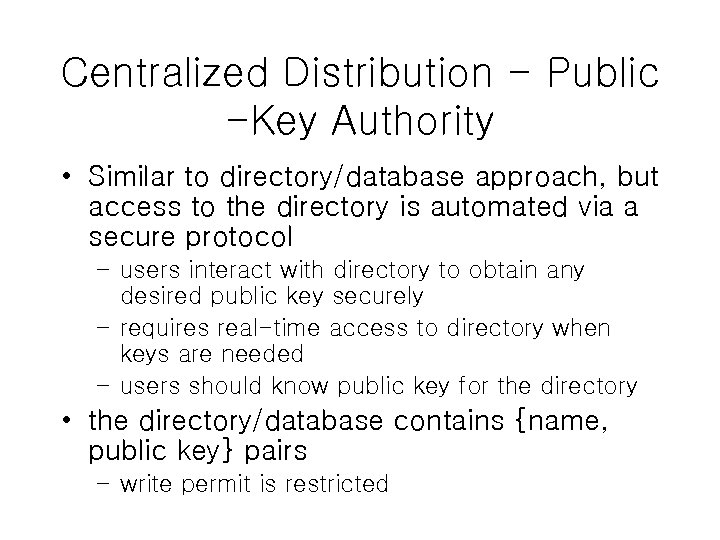
Centralized Distribution - Public -Key Authority • Similar to directory/database approach, but access to the directory is automated via a secure protocol – users interact with directory to obtain any desired public key securely – requires real-time access to directory when keys are needed – users should know public key for the directory • the directory/database contains {name, public key} pairs – write permit is restricted

Centralized Distribution – Public-Key Authority PROTOCOL
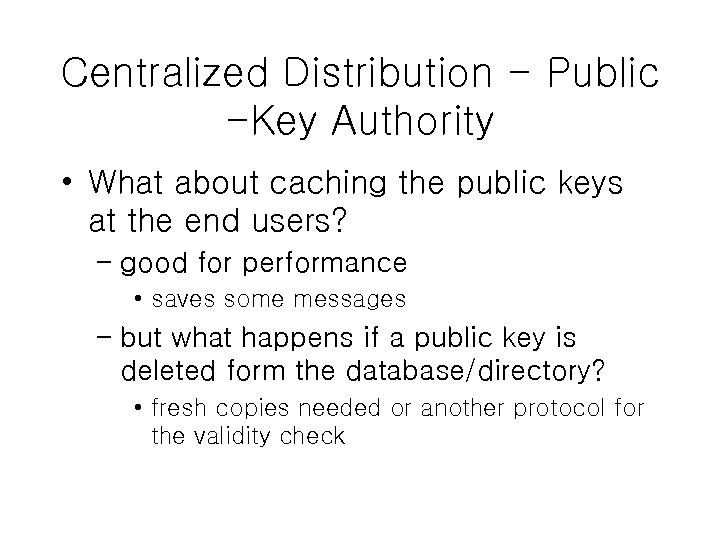
Centralized Distribution - Public -Key Authority • What about caching the public keys at the end users? – good for performance • saves some messages – but what happens if a public key is deleted form the database/directory? • fresh copies needed or another protocol for the validity check

Centralized Distribution - Public -Key Authority • Disadvantages – authority is an active entity and may create a performance bottleneck – database should be kept secure to prevent unauthorized modification – The problem of registration of publickeys is still unsolved!
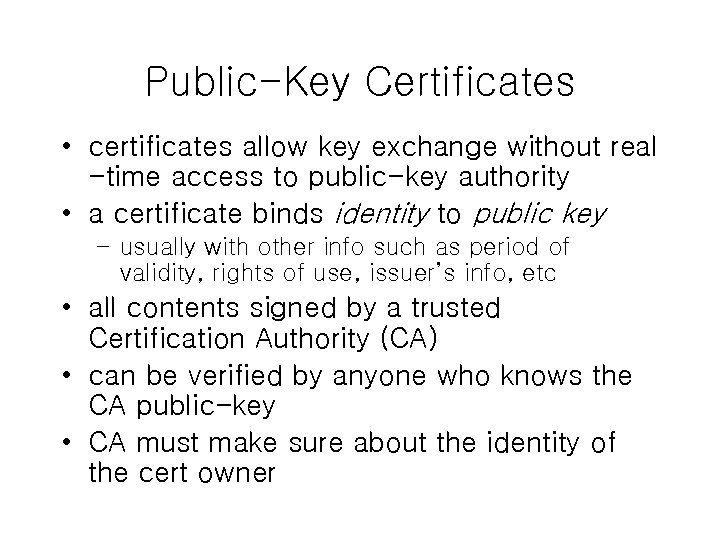
Public-Key Certificates • certificates allow key exchange without real -time access to public-key authority • a certificate binds identity to public key – usually with other info such as period of validity, rights of use, issuer’s info, etc • all contents signed by a trusted Certification Authority (CA) • can be verified by anyone who knows the CA public-key • CA must make sure about the identity of the cert owner

Public-Key Certificates
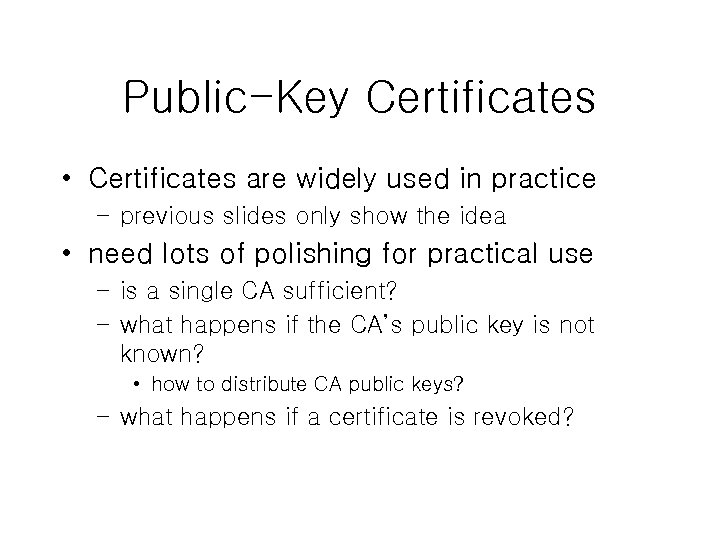
Public-Key Certificates • Certificates are widely used in practice – previous slides only show the idea • need lots of polishing for practical use – is a single CA sufficient? – what happens if the CA’s public key is not known? • how to distribute CA public keys? – what happens if a certificate is revoked?
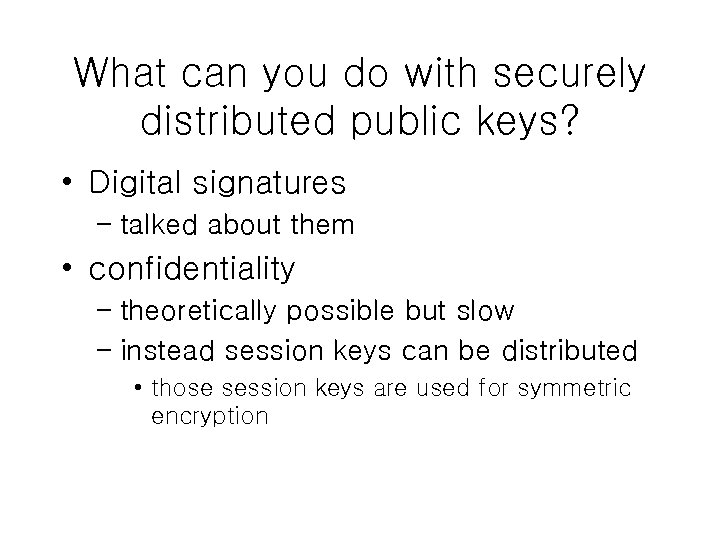
What can you do with securely distributed public keys? • Digital signatures – talked about them • confidentiality – theoretically possible but slow – instead session keys can be distributed • those session keys are used for symmetric encryption
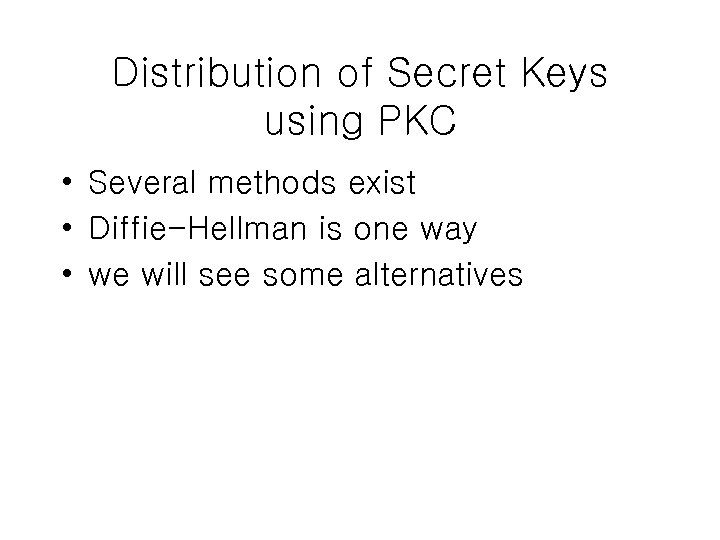
Distribution of Secret Keys using PKC • Several methods exist • Diffie-Hellman is one way • we will see some alternatives
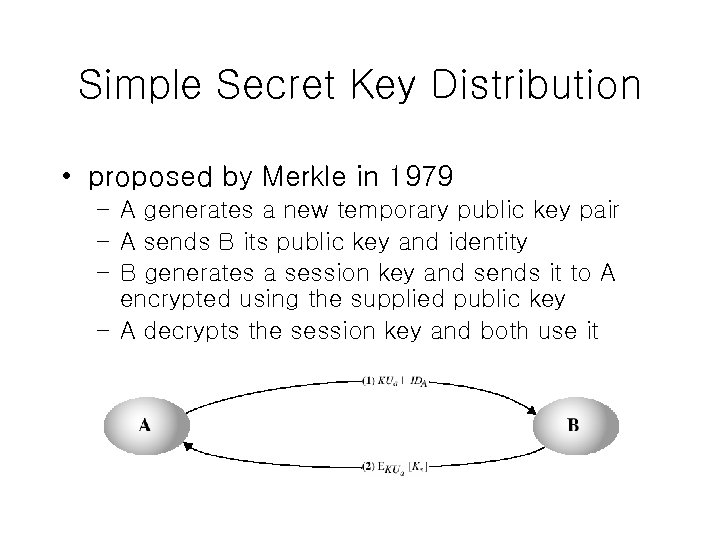
Simple Secret Key Distribution • proposed by Merkle in 1979 – A generates a new temporary public key pair – A sends B its public key and identity – B generates a session key and sends it to A encrypted using the supplied public key – A decrypts the session key and both use it
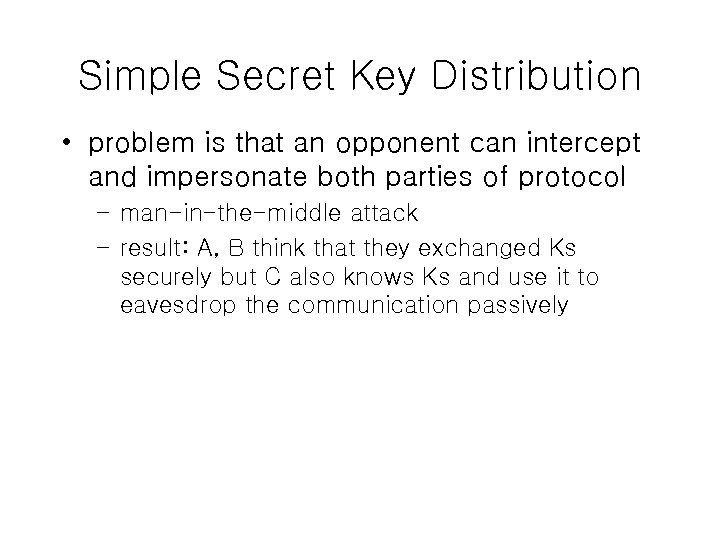
Simple Secret Key Distribution • problem is that an opponent can intercept and impersonate both parties of protocol – man-in-the-middle attack – result: A, B think that they exchanged Ks securely but C also knows Ks and use it to eavesdrop the communication passively
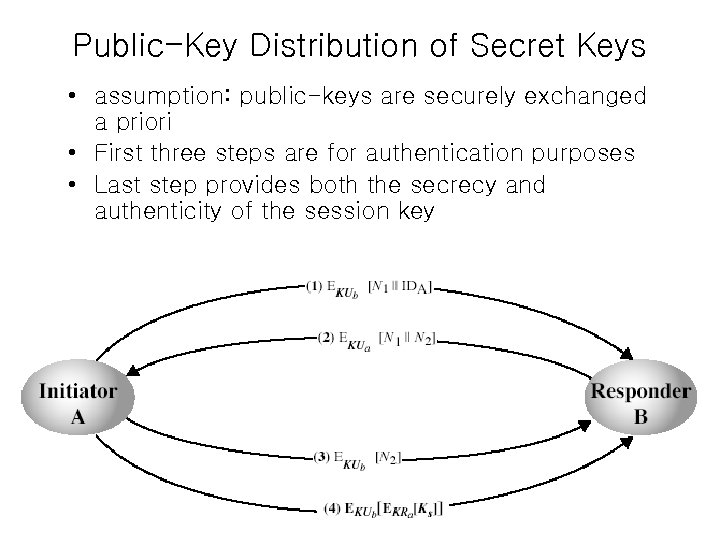
Public-Key Distribution of Secret Keys • assumption: public-keys are securely exchanged a priori • First three steps are for authentication purposes • Last step provides both the secrecy and authenticity of the session key
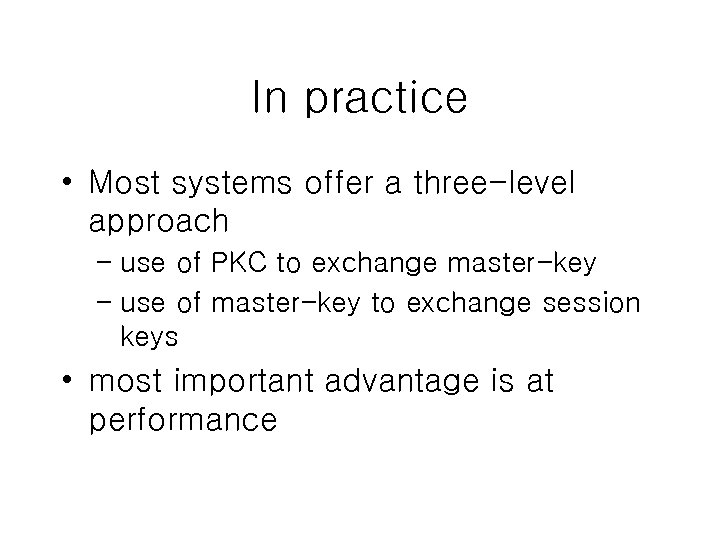
In practice • Most systems offer a three-level approach – use of PKC to exchange master-key – use of master-key to exchange session keys • most important advantage is at performance
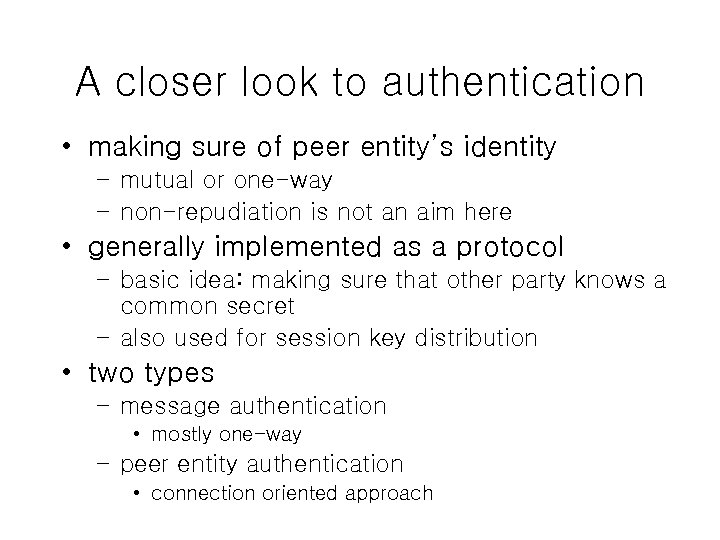
A closer look to authentication • making sure of peer entity’s identity – mutual or one-way – non-repudiation is not an aim here • generally implemented as a protocol – basic idea: making sure that other party knows a common secret – also used for session key distribution • two types – message authentication • mostly one-way – peer entity authentication • connection oriented approach
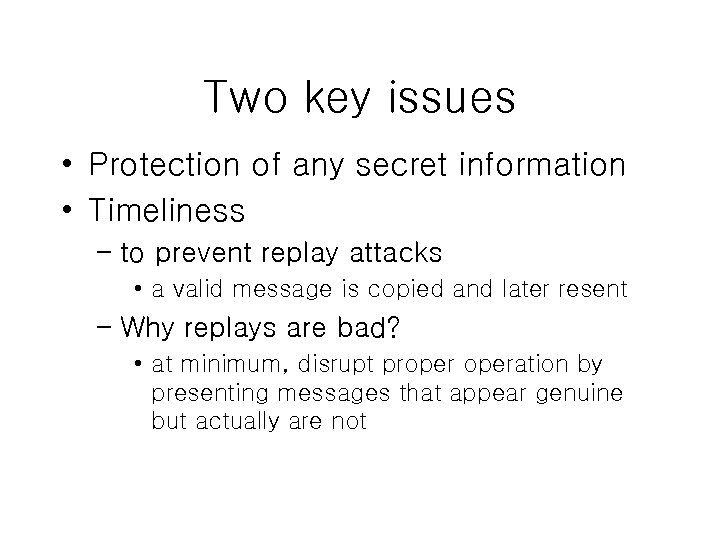
Two key issues • Protection of any secret information • Timeliness – to prevent replay attacks • a valid message is copied and later resent – Why replays are bad? • at minimum, disrupt properation by presenting messages that appear genuine but actually are not
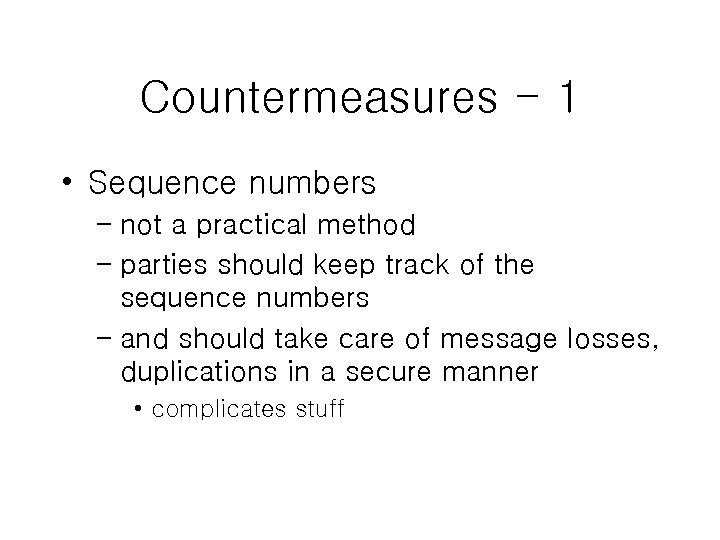
Countermeasures - 1 • Sequence numbers – not a practical method – parties should keep track of the sequence numbers – and should take care of message losses, duplications in a secure manner • complicates stuff
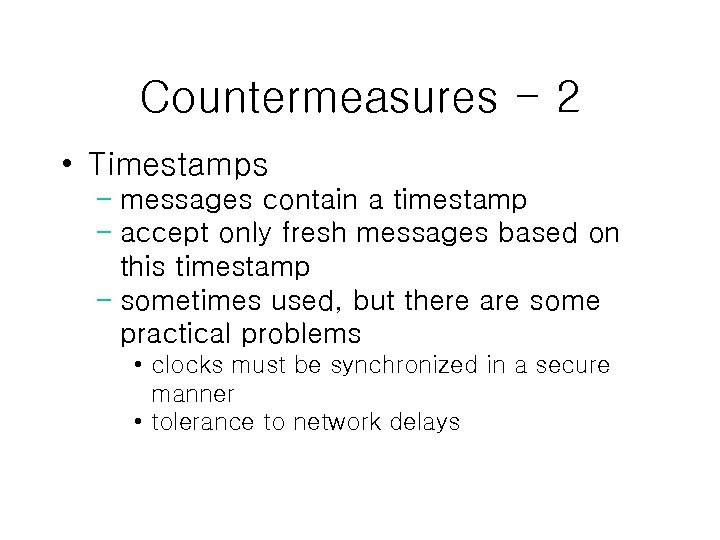
Countermeasures - 2 • Timestamps – messages contain a timestamp – accept only fresh messages based on this timestamp – sometimes used, but there are some practical problems • clocks must be synchronized in a secure manner • tolerance to network delays
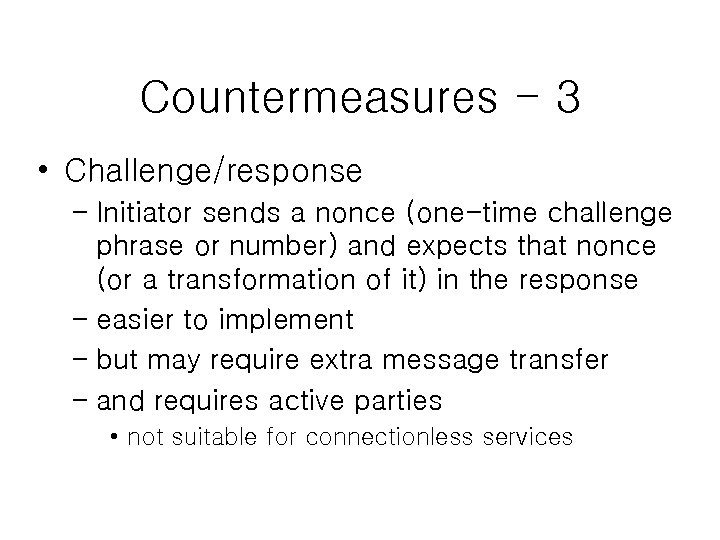
Countermeasures - 3 • Challenge/response – Initiator sends a nonce (one-time challenge phrase or number) and expects that nonce (or a transformation of it) in the response – easier to implement – but may require extra message transfer – and requires active parties • not suitable for connectionless services
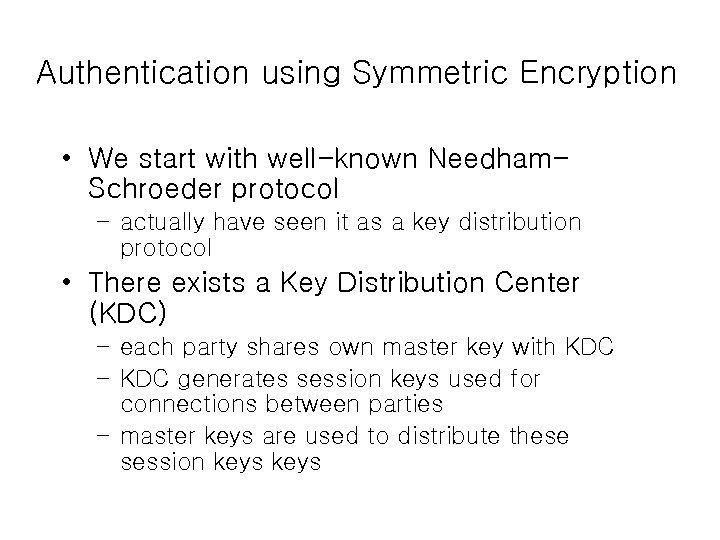
Authentication using Symmetric Encryption • We start with well-known Needham. Schroeder protocol – actually have seen it as a key distribution protocol • There exists a Key Distribution Center (KDC) – each party shares own master key with KDC – KDC generates session keys used for connections between parties – master keys are used to distribute these session keys
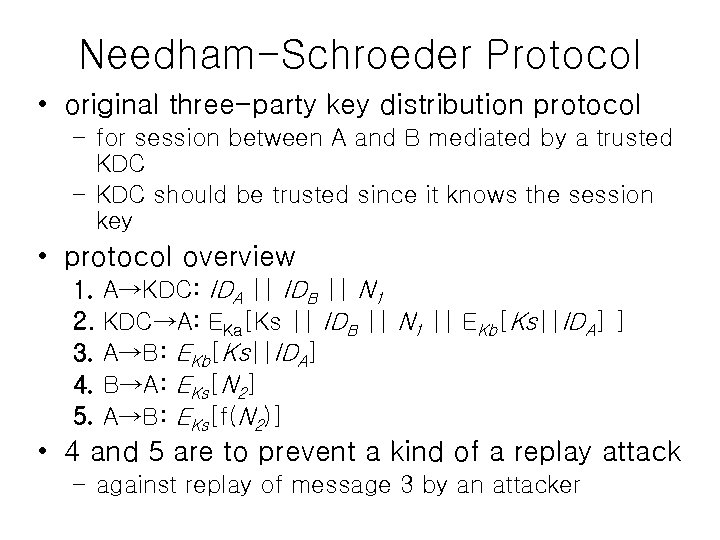
Needham-Schroeder Protocol • original three-party key distribution protocol – for session between A and B mediated by a trusted KDC – KDC should be trusted since it knows the session key • protocol overview 1. 2. 3. 4. 5. A→KDC: IDA || IDB || N 1 KDC→A: EKa[Ks || IDB || N 1 || EKb[Ks||IDA] ] A→B: EKb[Ks||IDA] B→A: EKs[N 2] A→B: EKs[f(N 2)] • 4 and 5 are to prevent a kind of a replay attack – against replay of message 3 by an attacker
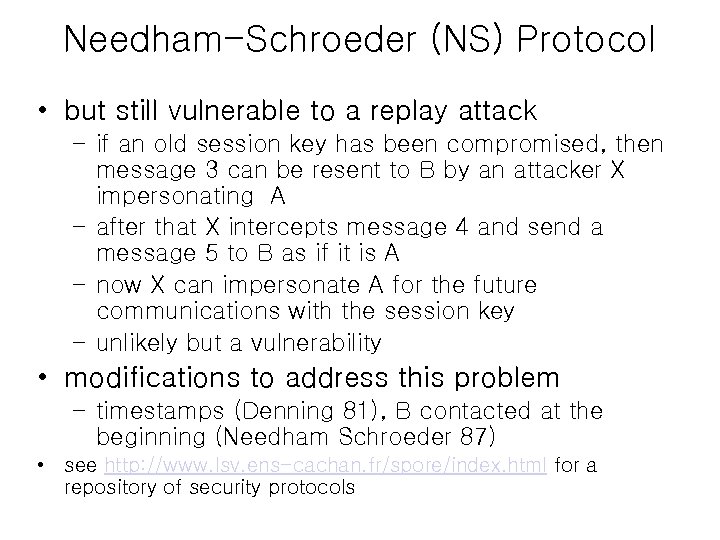
Needham-Schroeder (NS) Protocol • but still vulnerable to a replay attack – if an old session key has been compromised, then message 3 can be resent to B by an attacker X impersonating A – after that X intercepts message 4 and send a message 5 to B as if it is A – now X can impersonate A for the future communications with the session key – unlikely but a vulnerability • modifications to address this problem – timestamps (Denning 81), B contacted at the beginning (Needham Schroeder 87) • see http: //www. lsv. ens-cachan. fr/spore/index. html for a repository of security protocols
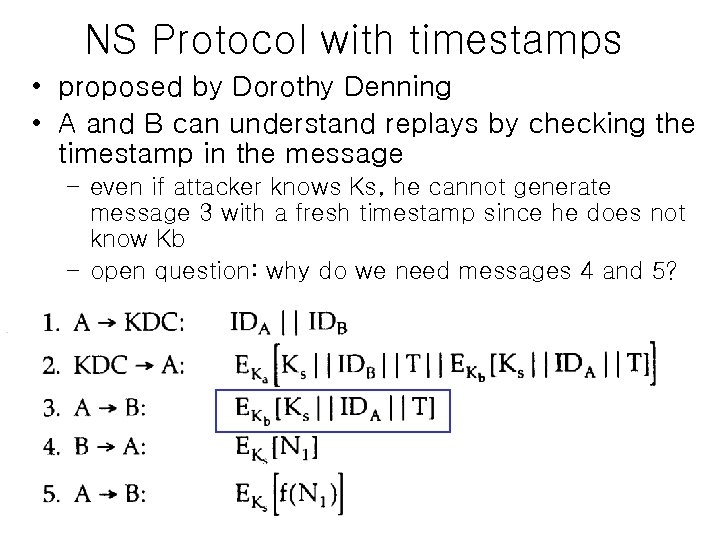
NS Protocol with timestamps • proposed by Dorothy Denning • A and B can understand replays by checking the timestamp in the message – even if attacker knows Ks, he cannot generate message 3 with a fresh timestamp since he does not know Kb – open question: why do we need messages 4 and 5?
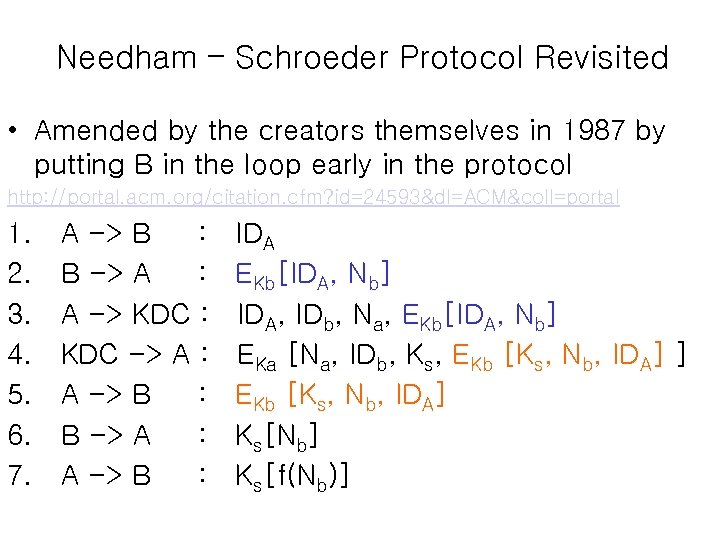
Needham – Schroeder Protocol Revisited • Amended by the creators themselves in 1987 by putting B in the loop early in the protocol http: //portal. acm. org/citation. cfm? id=24593&dl=ACM&coll=portal 1. 2. 3. 4. 5. 6. 7. A -> B : B -> A : A -> KDC : KDC -> A : A -> B : B -> A : A -> B : IDA EKb[IDA, Nb] IDA, IDb, Na, EKb[IDA, Nb] EKa [Na, IDb, Ks, EKb [Ks, Nb, IDA] ] EKb [Ks, Nb, IDA] Ks[Nb] Ks[f(Nb)]
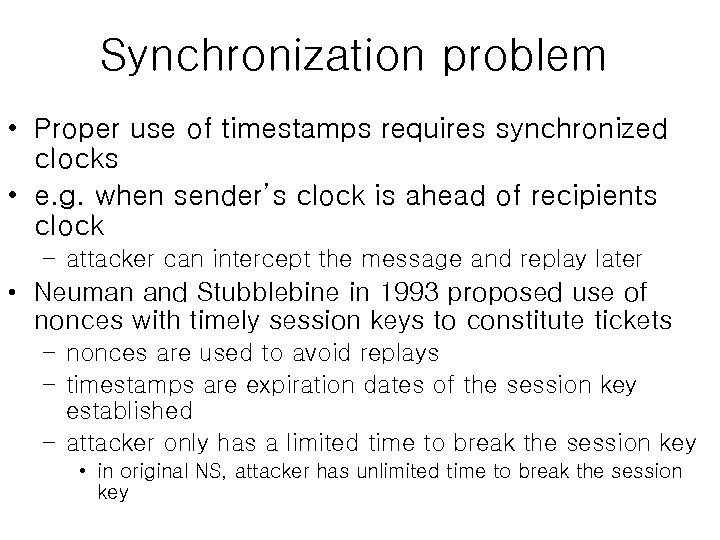
Synchronization problem • Proper use of timestamps requires synchronized clocks • e. g. when sender’s clock is ahead of recipients clock – attacker can intercept the message and replay later • Neuman and Stubblebine in 1993 proposed use of nonces with timely session keys to constitute tickets – nonces are used to avoid replays – timestamps are expiration dates of the session key established – attacker only has a limited time to break the session key • in original NS, attacker has unlimited time to break the session key
![Neuman Protocol • EKb[IDA || Ks || Tb] is a ticket that can be Neuman Protocol • EKb[IDA || Ks || Tb] is a ticket that can be](https://present5.com/presentation/f61e4991eb39b3717770069c4597cee0/image-175.jpg)
Neuman Protocol • EKb[IDA || Ks || Tb] is a ticket that can be used later within the limit of Tb
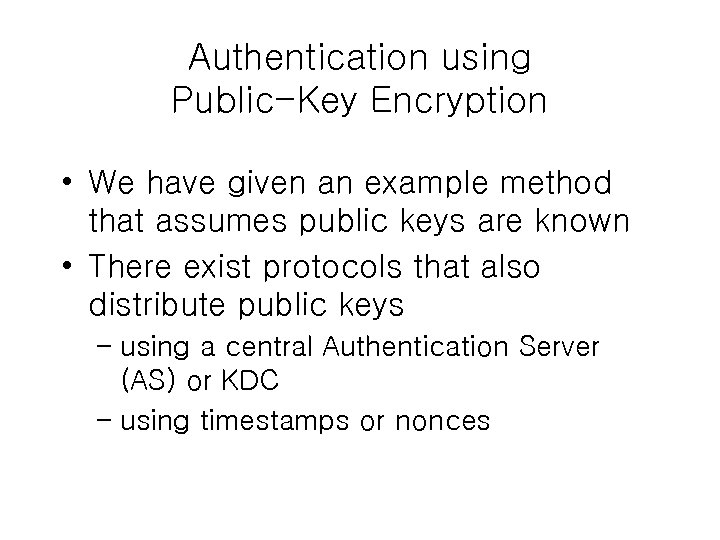
Authentication using Public-Key Encryption • We have given an example method that assumes public keys are known • There exist protocols that also distribute public keys – using a central Authentication Server (AS) or KDC – using timestamps or nonces
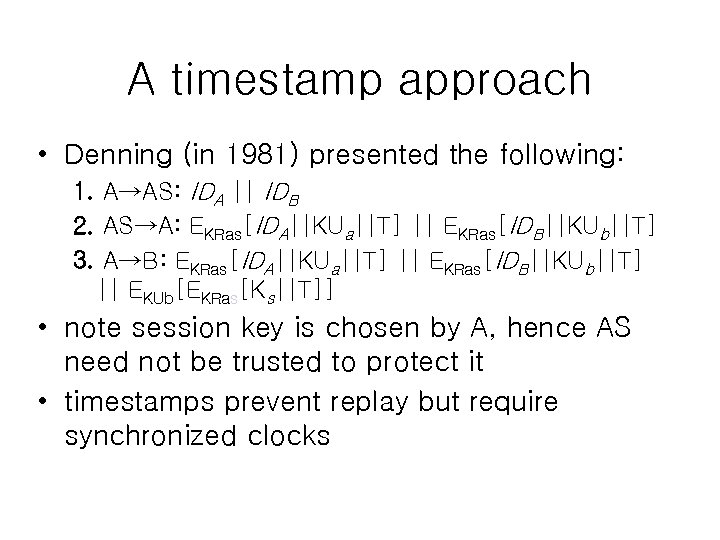
A timestamp approach • Denning (in 1981) presented the following: 1. A→AS: IDA || IDB 2. AS→A: EKRas[IDA||KUa||T] || EKRas[IDB||KUb||T] 3. A→B: EKRas[IDA||KUa||T] || EKRas[IDB||KUb||T] || EKUb[EKRas[Ks||T]] • note session key is chosen by A, hence AS need not be trusted to protect it • timestamps prevent replay but require synchronized clocks
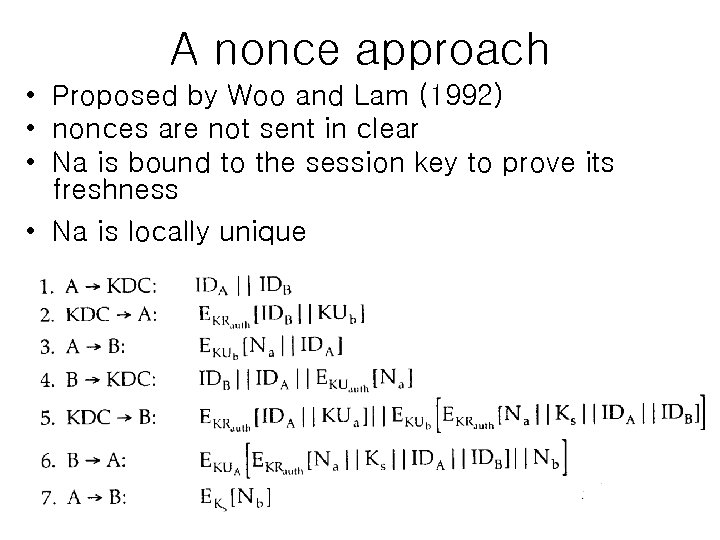
A nonce approach • Proposed by Woo and Lam (1992) • nonces are not sent in clear • Na is bound to the session key to prove its freshness • Na is locally unique
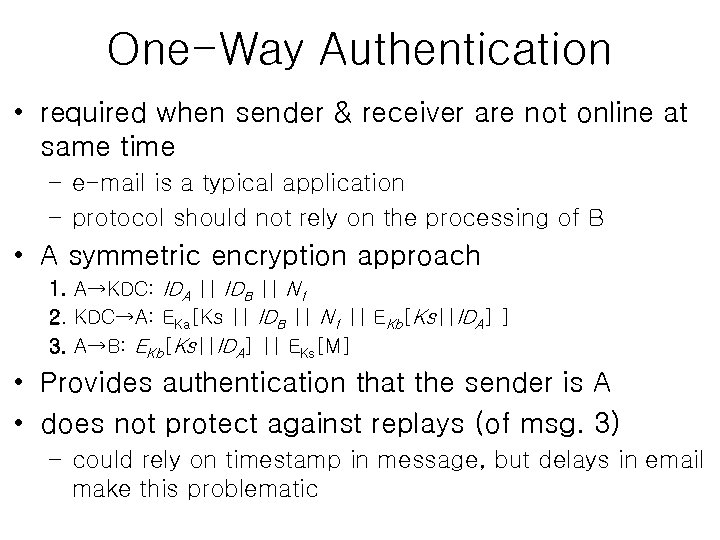
One-Way Authentication • required when sender & receiver are not online at same time – e-mail is a typical application – protocol should not rely on the processing of B • A symmetric encryption approach 1. A→KDC: IDA || IDB || N 1 2. KDC→A: EKa[Ks || IDB || N 1 || EKb[Ks||IDA] ] 3. A→B: EKb[Ks||IDA] || EKs[M] • Provides authentication that the sender is A • does not protect against replays (of msg. 3) – could rely on timestamp in message, but delays in email make this problematic
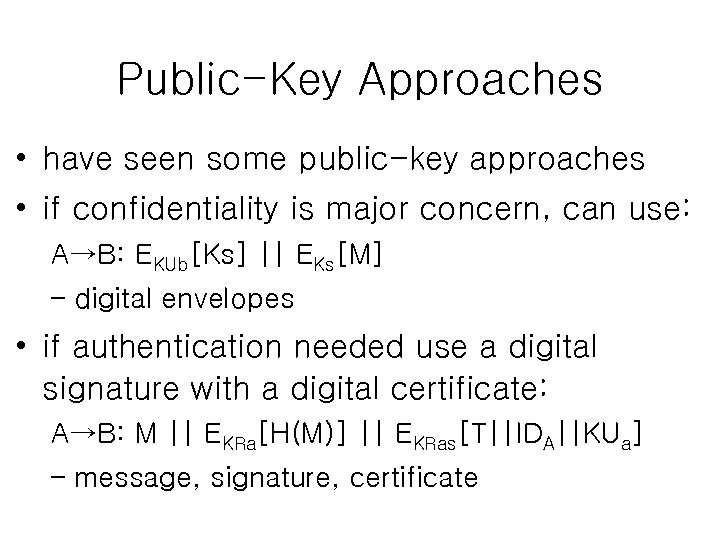
Public-Key Approaches • have seen some public-key approaches • if confidentiality is major concern, can use: A→B: EKUb[Ks] || EKs[M] – digital envelopes • if authentication needed use a digital signature with a digital certificate: A→B: M || EKRa[H(M)] || EKRas[T||IDA||KUa] – message, signature, certificate
f61e4991eb39b3717770069c4597cee0.ppt